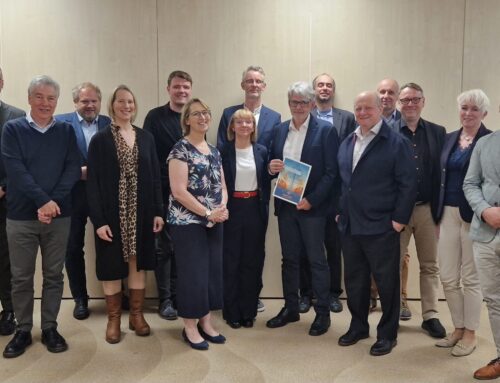
Challenges and potential in focus at International Hardwood Conference
International Hardwood Conference speakers covered a diverse range of topics; from growing pressures of market globalisation, to application of massive US white oak glulam beams in construction.
Organised in association with the European Timber Trade Federation (ETTF) and European Organisation of Sawmill Industries (EOS) by Italian trade federation Fedecomlegno, part of FederlegnoArredo, the event took place in Venice from November 15-17 and attracted a capacity audience of 150, drawn from 17 countries.
Fedecomlegno chairman Alessandro Calcaterra opened with a portrayal of a hardwood industry at a critical point, facing increasing and shifting global demand. “By 2030 Global roundwood consumption is set to rise 60%, making it ever more important where hardwood comes from, how it’s produced (FAO experts forecast one third will come from plantations by then) and where it’s used,” he said.
Looking at the current picture, analyst Rupert Oliver, of Forest Industries Intelligence, said latest statistics indicated 2017 global hardwood imports and exports both stable at $35 billion, with the industry continuing to show lack of value growth, despite rising world population. Underlying this static picture, however, was migration in the balance of market power, in both log and lumber consumption, principally to Asia and notably China. “China’s rise has been exponential,” said Mr Oliver. “Its 2016 log imports are expected to be 15.4 million tonnes, up from 14.3million in 2015, with lumber imports ahead 12.5% to nine million.”
Focusing on Europe, ETTF President Andreas von Möller described the contraction of its tropical wood imports in recent years as ‘sad’ and at least in part due to specifier misperceptions’ around the material’s legal and sustainable credentials. But, he added, with the exception of an uncertain UK, due to Brexit, European market prospects were generally positive, with most countries’ GDP and construction sectors trending up. This was a picture confirmed in his summary of European hardwood production by EOS Board Member Nicolae Tucunel.
However, a key hardwood market concern in Europe, said EOS President Sampsa Auvinen was raw material availability, principally due to rising emerging economy consumption of European logs. “We must insist on a level timber market playing field,” he said. “Without raw material the European sawmill industry will be forced out of the market.”
European raw material supply was also the theme of Marijan Kavran of the Croatian Wood Cluster, but in his case in terms of Croatia’s export controls to combat oak lace beetle infestation. Backed by EOS, he called for financial and technical support for new phytosanitary measures to eradicate the pest and for current restrictions on market flows in sawn timber and other safe goods, such as debarked and steamed logs to be lifted.
In terms of changing global timber consumption and trade patterns, the key trendsetter, agreed American Hardwood Export Council (AHEC) Executive Director Mike Snow, was and would continue to be China. His focus was the American hardwood sector’s transformation from being a largely US centred business to the world’s biggest hardwood lumber exporter, with nearly 50% of its grade timber sold abroad. China had played a critical part in this evolution.
“It has accounted for all our export growth since the 1990s and now buys one in four US hardwood grade boards,” said Mr Snow. What was concerning now though, he added, was rising Chinese consumption of US logs, creating potential competition both for US mills’ raw material and lumber exports.
Davide Pettenella of Padua University presented his research into the impact on global primary tropical timber trade trends of national and regional market legality regulation. This showed growth in tropical timber consumption in developing countries with less stringent legality controls, and declines in developed countries with stricter import rules. But Mr Pettenella cautioned against surmising simple cause and effect. Other factors, such as emerging countries’ economic advance and increasing trade regionalisation were also implicated in changing trade patterns.
In his focus on forest products flows, consultant Pierre Marie Desclos concluded that population growth would further accelerate timber sector regionalisation and sharpen the trade’s focus on raw material supply and logistics.
Growing global consumption of hardwood and the increasing significance this lends to sustainable forest management was also the backdrop to the launch of the International Tropical Timber Technical Association’s new ‘Fair & Precious’ branding initiative, said the latter’s General Secretary Benoît Jobbé-Duval. The brand is for use by the entire tropical timber supply chain and intended to add commercial market value to sourcing sustainably.
Turning to hardwood use, European Director David Venables described AHEC’s work supporting application of US species in engineered and thermally modified form in construction. The recent use of 23m, 4-tonne US white oak glulam beams as the core roof structure of a stand at the Lord’s Cricket Ground in London was a key breakthrough. But perhaps even more significant was construction, also in the UK, of the first permanent building in US tulipwood cross laminated timber panels. “CLT production is forecast to reach 1 million m3 next year,” said Mr Venables. “Softwood dominates the market, but imagine if hardwood took just a percentage.”
Other Conference speakers included Elvio Florian, of Italian hardwood producer and IHC main sponsor Florian Legno, Andreas Kleinschmit von Lengefeld of the European Hardwood Innovation Alliance, Maurizio Riva of Italian hardwood furniture specialist Riva, Joël Lefebvre of Group Lefebvre, Stefano Cora of Cora’Domenico & Figli and CNR Ivalsa researcher Nicola Macchioni.
For more information: http://info@ihc2017.info
For pictures: http://www.ihc2017.info/en/photogallery/
For presentations and participants list: http://www.ihc2017.info/en/presentations-list-of-partecipants/
Related Posts
Contact
EUROPEAN ORGANISATION
OF THE SAWMILL INDUSTRY AISBL
Rue Montoyer 24/box 20
BE-1000 Brussels
Tel.: +32 2 287 08 68
Email: info@eos-oes.eu



